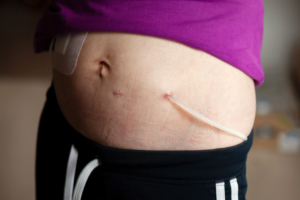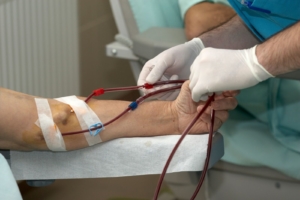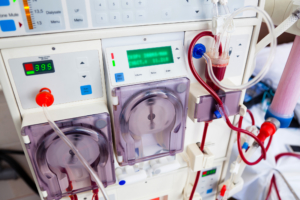Peritoneal Dialysis
Contents:
Many prospective patients think that their only option for end-stage renal disease (ESRD) is dialysis in a center at least three times a week for an average of four hours a session. This is not true, and there are several other options available including peritoneal dialysis (PD), home hemodialysis and transplants.
What is Peritoneal Dialysis?

Exit site for peritoneal dialysis catheter
Peritoneal Dialysis (PD) is a treatment that utilizes your peritoneum, a membrane lining your abdominal cavity, as a filter to remove wastes from your body. This type of dialysis requires a care partner to help with the process.
Your peritoneum does a similar job as the dialyzer on a dialysis machine during treatment or that your kidneys do every day. Waste products and fluid pass through the membrane into dialysate (dialysis fluid) and the fluid is drained with the waste products. Your peritoneum is what separates your blood from the dialysis fluid and allows the process to occur. Each time fluid is added to the abdomen and extra fluid and wastes are removed is called an exchange.
Peritoneal Dialysis has been used in the United States since the 1980’s, and improvements continue to be made to ensure it is a safe and effective treatment. There are potential benefits and negatives to the treatment.
Types of Peritoneal Dialysis
There are two ways to perform peritoneal dialysis, Continuous-Cycler Assisted Peritoneal Dialysis (CCPD) and Continuous Ambulatory Peritoneal Dialysis (CAPD), which are outlined below.
Continuous Cycling Peritoneal Dialysis
Continuous cycling peritoneal dialysis (CCPD) is a method of performing peritoneal dialysis exchanges using a machine called a cycler during your sleeping hours. Generally, three to five exchanges are done each night. There is an option to drain directly to your toilet or a drain or into drain bags that you would empty when you wake up in the morning. This program frees up your daytime hours. Each nightly session lasts at least eight to ten hours. Some programs leave you with a set amount of dialysate at the end of your treatment that will dwell during the day.
Continuous Ambulatory Peritoneal Dialysis
Continuous ambulatory peritoneal dialysis (CAPD) is a method of performing peritoneal dialysis exchanges using gravity to drain and fill your peritoneal membrane with solutions four times each day, spaced evenly throughout the day. It usually takes about 30 minutes to complete an exchange. The exchanges can be done in a clean environment, and you are free to be active during each dwell.
Peritoneal Dialysis Catheter
To prepare for PD therapy, you need to undergo a small surgical procedure to have a catheter inserted into your abdomen. The catheter is a small rubber tube that is placed into the wall of your abdomen and secured using Dacron cuffs. Generally, two cuffs are used in adults and they help secure your catheter and prevent some forms of infections. The catheter is your entry and exit point for dialysate and for waste products.
Catheter placement
The surgery itself can be done in several different ways. It can be done percutaneous, through a laparoscopic surgery or an open surgical route. The laparoscopic and open surgery techniques are preferred because there are additional risks such as bowel injury with the percutaneous method.
Laparoscopic surgery – is a minimally invasive technique when the operation is performed through a small incision. A laparoscope (type of small camera) is used to view the operation site and place the catheter.
Percutaneous surgery – involves a guidewire being placed inside of tube. The guidewire is then used to place the catheter into the correct spot and a tunnel is made under the skin to the exit site. This is also a less invasive technique, but could have complications due to the nature of the surgery.
Open surgery – is where a scalpel is used to but a tiny incision through your skin and muscle of your abdomen. The “open” area allows the surgeon to place the catheter and the wound is stitched around it. This is the largest incision, but most common surgery.
A similar surgery that takes place in the chest as compared to the abdomen is the use of a presternal catheter. During surgery the longer catheter is placed into the chest using two small incisions. The device has two rubber tubes connected by a metal connector. Since the chest skin is less likely to move and thinner than the abdomen, this could be a good option for children or heavier adults. Patients are also able to bathe with these as long as water levels aren’t up to the catheter.
As with any surgery there can be complications including infections and bleeding. Working with your healthcare team to properly care for your catheter can greatly reduce complications. The most common types of issues involve catheter placement, infections and blockages.
Peritoneal Dialysis Training
After your catheter has healed, you will begin training. Training differs from office to office, but the basics remain the same. During PD training you will learn how to:
- Prepare to do an exchange
- Practice safe sterile practice
- Do the exchange itself
- Order supplies you need and how to store
- Follow your fluid and diet restrictions
- Do basic troubleshooting and when to call for additional help
- Use your cycler (if you have one)
Once you have been trained and feel comfortable doing PD, you will be ready to do exchanges yourself.
Steps for Doing a Peritoneal Dialysis Exchange
Here is a great animation of the process.
For those of you that prefer text over a video, here are the steps of a CAPD exchange. (Please note this is a generalization and shouldn’t replace the steps given to you by your medical team).
- Wash your hands with proper antibacterial soap.
- Clean the surface where you will place your supplies and check the expiration dates on your supplies.
- Open up your bag of dialysate.
- Wash your hands again after touching the dialysate bag.
- Connect your protector to the dialysate’s opening to prevent infection.
- Hang the fresh dialysate solution bag at your station above your head.
- Connect your catheter line to the protected end of the dialysate bags.
- Open the clamp to the drain bag and the old fluid will begin to drain into the empty bag.
- Allow the fluid that is currently in your abdomen to drain out into the empty bag placed on a low surface or on the floor. This process takes about 20 minutes.
- Turn the position on the transfer set to allow fresh dialysate to drain into your abdomen, which takes about 5 minutes.
- After the fill portion has completed, turn the close the clamp.
- Use the disconnection cap to close off the open end of the catheter.
- The bag of collected old fluid can be disposed of in the toilet.
- The bag itself can be collected in a medical waste container.
- The dialysate that was added will need time to dwell or rest and will remain in your abdomen until your next exchange or overnight if this was your last exchange for the day.
- The process will be repeated anywhere from 3-5 times a day as prescribed by your physician.























